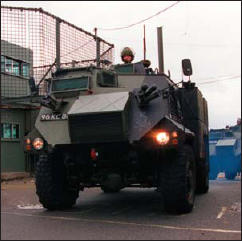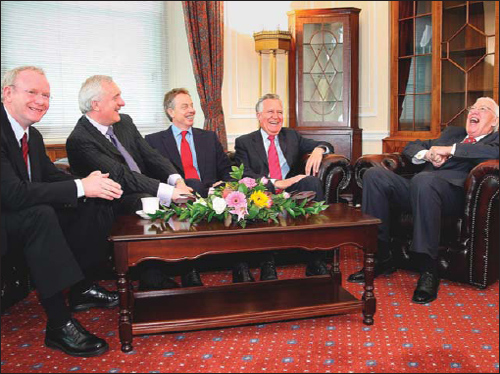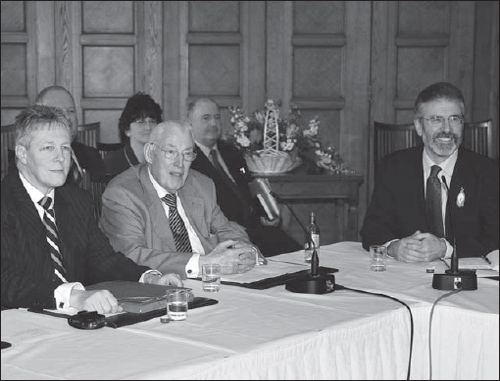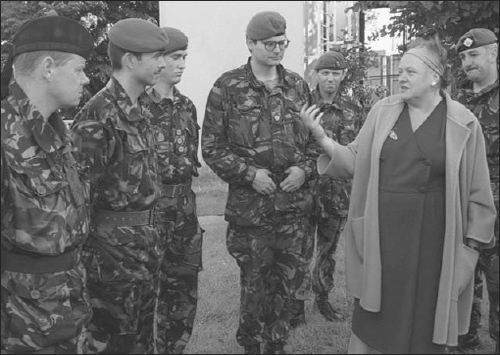
Armed conflicts are typically followed by an audit of their causes and consequences. Those directly affected by the violence may be in search of reasons why it was visited on them and keen to find out whether the legacy of the past can be addressed in a manner that prevents a reoccurrence. Often, the parties to an ethnic conflict – such as the groups and communities diametrically opposed to each other – look back at what happened through rose-tinted glasses. It is unsurprising, therefore, that debates over the past in Northern Ireland have become more audible as the sounds of gunfire and explosions fade into the background.
Drawing lessons from armed conflicts is fraught with many pitfalls. Not all of them have similar causes, continuities and consequences. While it is tempting to draw comparisons between the British Army’s involvement in Northern Ireland and how it has approached contemporary operations elsewhere, such as in Iraq and Afghanistan, one must be careful not to make too many bold assumptions. Reflecting on his involvement in bringing an end to the Troubles, former British Prime Minister Tony Blair said, ‘I know this from the Middle East peace process now, that I’m engaged in intimately, that one of the things that gives them hope is the success of the Northern Ireland process. It’s a big symbol of change and possibility right round the world.’ While this may be true, it is also indicative of the flawed belief that all conflicts can be resolved using the same formula.

Troops from the King’s Regiment exit Girdwood Barracks, North Belfast, in Saxon armoured vehicles. The wire mesh round the sangar was a security measure designed to deflect rocket-propelled grenades. (IWM HU 98390)
Reflecting back over his 50-year career as a soldier, Field Marshal Bernard Montgomery concluded in his memoirs that ‘[w]e cannot see into the future accurately. But we can at least ensure that we do not disregard the lessons of the past: only a madman would do that.’ As an institution the British Army actively sought to capture its own lessons from its deployment in Northern Ireland. These ranged from doctrine and training to the execution of major and minor operations. In the Army’s official ‘lessons learned’ pamphlet, Operation Banner: An Analysis of Military Operations in Northern Ireland, there is a suggestion that the campaign was – on balance – a success, but that several key points ought to be noted for future operations.
The first is that there was no overall campaign authority for Operation Banner. Here the pamphlet argued that the decision-making process was chaotic at times and resulted in – among other things – the intelligence agencies working to different agendas. This is a valid point made by authors such as Desmond Hamill and Mark Urban. Nevertheless, it is no coincidence that the Provisional IRA re-organized for its ‘long war’ strategy in the late 1970s, adopting a cellular unit structure, just as the increase in Britain’s covert operations gathered momentum. It could be argued, however, that British military operations in Iraq between 2003 and 2009 also lacked such an overarching campaign authority. Furthermore, it is difficult to see how it could have been otherwise, when the Army played only a supporting role in Northern Ireland.

First Minister Ian Paisley and Deputy First Minister Martin McGuinness entertain Taoiseach Bertie Ahern, Prime Minister Tony Blair and Secretary of State for Northern Ireland Peter Hain on 8 May 2007. (© Paul Faith/Pool/epa/Corbis)
At a tactical level the Army learned a huge amount from Operation Banner. Respected journalist Patrick Bishop drew parallels with Afghanistan, concluding how ‘[t]here are some similarities. The skills and drills honed on the terraced streets of Belfast and Londonderry and the fields of Fermanagh and Tyrone have proved surprisingly useful in the river valleys of Helmand.’ The Army’s training regime was second to none in preparing troops for deployment in-theatre, taking soldiers through tutorials on the IRA’s arsenal of weapons, its bomb-making techniques, as well as its use of shoot-and-scoot tactics and armed propaganda (the use of violence to influence the wider political context). All this corporate knowledge came at a price, however, as it was built up from the direct exposure to terrorist violence.
As Carl von Clausewitz observed in On War, ‘[w]ar is the realm of physical exertion and suffering. These will destroy us unless we can make ourselves indifferent to them, and for this birth or training must provide us with a certain strength of body and soul.’ In the abnormal environment of Northern Ireland soldiers conditioned themselves to adapt and survive under unimaginable stress, and mitigate the often-imminent threat to their lives. In Operation Banner, the Security Forces fought a ‘battle of wills’ against Republican and Loyalist terrorist groupings, holding the line while political initiatives attempted to forge a lasting peace in Northern Ireland.
Perhaps the biggest single stimulant in the Army’s lesson-learning process was the decision by senior military commanders to take steps to avoid repeating mistakes. This willingness to admit its mistakes – while actively taking steps to ensure they are not repeated – is a prime example of the Army’s professional ability to learn and adapt in highly pressurized environments. Reflecting on the release of the Saville Inquiry4 report into ‘Bloody Sunday’, the Chief of the General Staff (subsequently Chief of the Defence Staff) Sir David Richards, said:
We must never forget the tragic events of Bloody Sunday. In the 38 years since that tragic day’s events, lessons have been learned. The way the Army is trained, the way it works and the way it operates have all changed significantly.
Joining General Richards in his comments, his predecessor General Sir Mike Jackson, himself a veteran of the Troubles, said:
I recall that nearly 40 years ago in Northern Ireland the situation was grim with significant loss of life on all sides – not least by the Army. Over the 38 years of the Army’s operational deployment in the province the vast majority of the some 250,000 soldiers who served there behaved admirably, often in the face of severe provocation, and with the loss of several hundred lives and 6,000 wounded. Northern Ireland today is now a very different place, not least because of those sacrifices and I ask that Lord Saville’s report be seen in this context.
The Army had indeed learnt valuable lessons in Northern Ireland, just as it has done in all of its operational theatres since 1945.
Notwithstanding these candid admissions, there has also been a tendency to learn the wrong lessons from Operation Banner. The Army’s official pamphlet on military operations in Northern Ireland said for instance that the ‘few bombs that were placed in Service married quarters areas appear to have been placed to tie down troops, rather than to kill or maim. The reasons probably lie in the self-image of the IRA as an Army with its own sense of morality, honour and justice.’ While on the face of it such monochrome remembrances of the Troubles are harmless, they serve to seriously underplay the ruthlessness of terrorist groups like the IRA. Moreover, by playing up the political ‘nobility’ of the Republican campaign this account obscures the brutal reality of IRA violence and constructs misleading interpretations out of bad history.
Rather than consciously avoid casualties among its opponents, the IRA deliberately targeted Security Forces personnel and the civilians working for them. In 1972 the Official IRA carried out a no-warning bombing of 2 Para’s mess in Aldershot Army Garrison, Hampshire, killing six civilian workers and a Roman Catholic padre. In the late 1980s the IRA attempted to mortar the families’ quarters in a UDR barracks at Steeple in Antrim. And in perhaps the most brazen attempt to kill and maim Security Forces personnel, the IRA detonated two huge car bombs in Thiepval Barracks, Lisburn, killing one soldier and injuring over 20 civilian and military personnel, on 7 October 1997. In undertaking these operations and countless others, the IRA earned a reputation as one of the most ruthless terrorist organizations in history.

Old enemies agree a timetable for power-sharing. Ian Paisley and Gerry Adams – as leaders of the two largest parties – finally agree to form a power-sharing executive. Seated next to Paisley is his deputy Peter Robinson, who succeeded him when he stepped down in 2008. (© Pool/Reuters/Corbis)
Like the Army, the British government also learned lessons from its long involvement in Northern Ireland. In a speech to the Mid-Atlantic Club in Washington, DC, on 17 October 1977 the then-Northern Ireland Secretary of State, Roy Mason, said: ‘Perhaps one of the most important lessons learned in Northern Ireland over the past few years – and it is a lesson which has important international implications – is that in a democratic society there is no way forward through the use of violence.’
This was a recurrent theme in the government’s official language throughout the Troubles. It dovetailed with security policy in implying that there could be no military solution to the conflict. Thus, the main task of the police and Army was to stabilize the security situation while various political initiatives were attempted, from the Sunningdale Agreement in 1973 through to the Good Friday Agreement in 1998. The political context was vitally important as it permitted the British government to enter into negotiations with the Provisional IRA at opportune moments in the 1970s, 1980s and 1990s. In the words of journalist Malachi O’Doherty:
Another lesson for militants and state security forces: don’t kill anybody unless you really have to. Especially, do not kill the leaders of the militant groups. If you want leaders to be able to control the whole movement underneath them, then you have to leave them in place for long enough to secure credibility and influence. Don’t fragment an enemy you ultimately hope to negotiate with.
The willingness of states to ‘talk to terrorists’ has become more evident since the bedding-down of the peace process in the late 1990s. The merits of dialogue between representatives of the various terrorist groups and the British and Irish governments have been recognized and applauded on the world stage. However, it is often forgotten how political space was created only in the wake of an application of coercion, mainly on the part of the British government and its Security Forces, both to cajole and entice these groups into suing for peace.




From the late 1970s the British government returned to the first principle that in combating terrorism and insurgency, the lead must always be taken by the civilian authority. A number of directives were issued through the Northern Ireland Office and a new plan, The Way Ahead, placed the RUC at the forefront of the counter-terrorist fight. Police–Army co-operation at the operational and tactical levels had become a success story by the mid-1990s.
Without question, the single biggest group affected by the Troubles was the local civilian population. Comparing conflict-related deaths is a macabre business. The number of deaths in Northern Ireland might seem small compared with the total population, but scaled proportionately, had the conflict taken place in Great Britain, it would have claimed 100,000 lives, or 500,000 in the United States.
The detailed analysis of Security Forces deaths is equally revealing. Estimates for the number of service personnel killed in action during Operation Banner vary. In 2007 the former Chief of the Defence Staff, Sir Jock Stirrup, put the figure at 651 and 6,307 wounded, while an official MoD tally from 2008 records a total of 763 (and 6,116 wounded), a figure which includes 651 Army and Royal Marines personnel, one Royal Navy serviceman, 50 members of the UDR/Royal Irish Regiment, ten members of the Territorial Army, and 51 military personnel murdered outside Northern Ireland. These figures are, however, somewhat misleading. The more reliable CAIN/Malcolm Sutton database puts the number of fatalities much higher. Between 1969 and 1997, it records the deaths of 502 British Army and Royal Marines personnel, 203 members of the UDR/RIR, seven Territorial Army members and 58 military personnel murdered outside Northern Ireland, giving a total of 770 military personnel killed. In contrast, the RUC lost 301 officers. However, these statistics mask the oft-forgotten truth that 40 former members of the UDR and 18 former members of the RUC died at the hands of Republican terrorists, for the IRA did not distinguish between on-duty, off-duty and former members. Other MoD statistics show that the UDR/RIR suffered 274 dead between 1971 and 2002, disproportionately higher than any other British Army regiment.




In comparable terms one could argue that Operation Banner was just as intense as Operation Telic, the British intervention in Iraq. Of the 179 British service personnel killed in Iraq between 2003 and 2009, 113 died in hostilities; the remainder included seven killed in ‘friendly fire’ incidents, 45 in accidents, two by suicide, and 12 in other circumstances. In sharp contrast to Operation Telic, Britain’s involvement in Afghanistan has been much bloodier. While only five soldiers died between 2001 and 2005, a total of 300 personnel have been killed in hostilities since 2006. A further 35 have died from disease, non-combat injuries or accidents. To date (writing in March 2011), 2009 was the bloodiest year for British forces in Afghanistan, with 108 military personnel killed in action. It is worth keeping this in mind because in the four years after 1971, when the IRA went on the offensive against British troops, approximately 318 soldiers were killed by hostile action.

Secretary of State for Northern Ireland Dr Mo Mowlam visits soldiers during operations at Drumcree on 10 July 1998. (IWM HU 98386)
Over the course of Operation Banner the number of Security Forces members and civilians killed averaged about one to two every day for the 25-year period between 1969 and 1997. The bloodiest year of the Troubles was 1972, when 497 people died, including 130 British soldiers. The most dangerous areas for Security Forces personnel throughout the Troubles were County Armagh, West Belfast and County Tyrone. One ‘taboo’ subject often overlooked by books on Operation Banner is the high number of deaths indirectly related to the Troubles; from road traffic accidents to suicides brought about by post-traumatic stress disorder. Although it is difficult to estimate how many soldiers have taken their own lives, the Police Federation for Northern Ireland has said that up to 70 RUC/PSNI officers have committed suicide, many with their personal-issue service revolver. In his excellent oral history research on the Army in Northern Ireland, Ken Wharton assembled a complete Roll of Honour, which – incredibly – records over 1,300 military deaths.
The human cost of violence is poorly reflected in the journalistic and academic literature on the Troubles. Because of the political core of the Republican and Loyalist terrorist campaigns, there has been a tendency to glorify the ‘noble dead’ and revise history to suit present-day political agendas. Poets, on the other hand, have been more forthright in their stark warnings of the futility of sectarian conflict. In his poem ‘Wounds’, Michael Longley gives us an insight into how the Troubles permeated every aspect of everyday life:
Also a bus-conductor’s uniform –
He collapsed beside his carpet-slippers
Without a murmur, shot through the head
By a shivering boy who wandered in
Before they could turn the television down
Or tidy away the supper dishes.
To the children, to a bewildered wife,
I think ‘Sorry Missus’ was what he said.
Despite the optimism unleashed by the 1994 ceasefires and the Good Friday Agreement almost four years later, the Troubles served to strengthen the deep ethnic, national and religious fault-lines. And while the paramilitary ceasefires may have triggered a winding-down of the military campaigns, the sectarianism that animated these struggles has not lessened. The Troubles have left behind a terrible legacy, of dead and wounded on all sides, scarring people it affected both directly and indirectly, not only in Northern Ireland, but also across the British Isles, in a way that may take generations to heal. At one time many people thought the conflict was simply insoluble. Nevertheless, the transformation from long war to long peace has marked a step-change in relationships between Protestant Unionist and Catholic nationalist communities. The history of Operation Banner offers us the opportunity to understand the past and to draw lessons from what really happened, so that similar tragedies can be avoided in the future.
4 Lord Saville was chosen by the New Labour government to head up the ‘Bloody Sunday’ Inquiry in 1998. A former High Court Judge, he was appointed a Law Lord in 1997 and went on to become Justice of the Supreme Court of the United Kingdom between 2009 and 2010. He was hand-picked because he was considered to be ‘less stuffy’ and more of ‘a modernizing judge’, who could navigate a route through the choppy waters of this emotionally intense episode in Northern Ireland’s past.